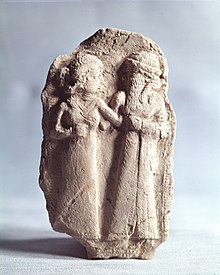| Dumuzid | |
|---|---|
 | |
| Abode | Heaven (for half the year); Kur (for the other half) |
| Genealogy | |
| Parents | Enki and Duttur |
| Siblings | Geshtinanna (sister), Amashilama (not usually, but in some texts said to be his sister) |
| Consort | Inanna (later known as Ishtar) |
| Equivalents | |
| Greek | Adonis |
| East Semitic | Tammuz |
| Levantine | Tammuz/Adonis |
Dumuzid or Dumuzi or Tammuz (Sumerian: 𒌉𒍣, romanized: Dumuzid; Akkadian: Duʾūzu, Dûzu; Hebrew: תַּמּוּז, romanized: Tammūz),[a][b] known to the Sumerians as Dumuzid the Shepherd (Sumerian: 𒌉𒍣𒉺𒇻, romanized: Dumuzid sipad)[3] and to the Canaanites as Adon (Phoenician: 𐤀𐤃𐤍; Proto-Hebrew: 𐤀𐤃𐤍), is an ancient Mesopotamian and Levantine deity associated with agriculture and shepherds, who was also the first and primary consort of the goddess Inanna (later known as Ishtar). In Sumerian mythology, Dumuzid's sister was Geshtinanna, the goddess of agriculture, fertility, and dream interpretation. In the Sumerian King List, Dumuzid is listed as an antediluvian king of the city of Bad-tibira and also an early king of the city of Uruk.
In Inanna's Descent into the Underworld, Inanna perceives that Dumuzid has failed to properly mourn her death and, when she returns from the Underworld, allows the galla demons to drag him down to the Underworld as her replacement. Inanna later regrets this decision and decrees that Dumuzid will spend half of the year in the Underworld, but the other half of the year with her, while his sister Geshtinanna stays in the Underworld in his place, thus resulting in the cycle of the seasons. In the Sumerian poem Inanna Prefers the Farmer, Dumuzid competes against the farmer Enkimdu for Inanna's hand in marriage.
Gilgamesh references Tammuz in Tablet VI of the Epic of Gilgamesh as the love of Ishtar's youth, who was turned into an allalu bird with a broken wing. Dumuzid was associated with fertility and vegetation and the hot, dry summers of Mesopotamia were believed to be caused by Dumuzid's yearly death. During the month in midsummer bearing his name, people all across Mesopotamia would engage in public, ritual mourning for him. The cult of Dumuzid later spread to the Levant and to Greece, where he became known under the West Semitic name Adonis.
The cult of Ishtar and Tammuz continued to thrive until the eleventh century AD and survived in parts of Mesopotamia as late as the eighteenth century. Tammuz is mentioned by name in the Book of Ezekiel (e.g., Ezek. 8:14–15) and possibly alluded to in other passages from the Hebrew Bible. In late nineteenth and early twentieth century scholarship of religion, Tammuz was widely seen as a prime example of the archetypal dying-and-rising god, but the discovery of the full Sumerian text of Inanna's Descent in the mid-twentieth century appeared to disprove the previous scholarly assumption that the narrative ended with Dumuzid's resurrection and instead revealed that it ended with Dumuzid's death. However, the rescue of Dumuzid from the underworld was later found in the text Return of Dumuzid, translated in 1963.
- ^ Lung 2014.
- ^ Mitchell 2005, p. 169.
- ^ "The Electronic Text Corpus of Sumerian Literature". etcsl.orinst.ox.ac.uk. Archived from the original on 2015-09-08. Retrieved 2017-08-29.
Cite error: There are <ref group=lower-alpha> tags or {{efn}} templates on this page, but the references will not show without a {{reflist|group=lower-alpha}} template or {{notelist}} template (see the help page).